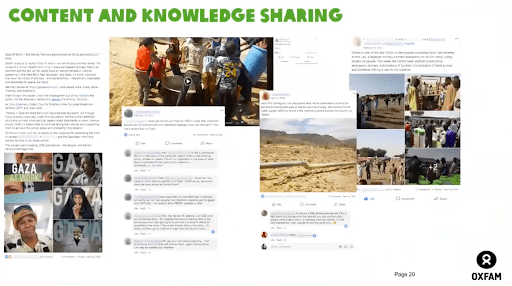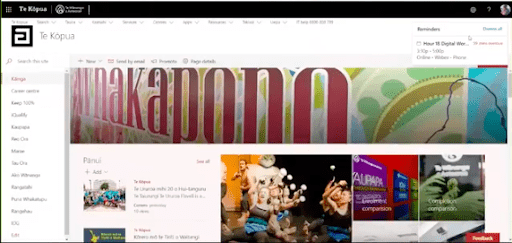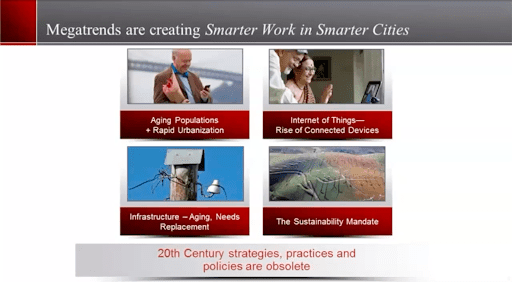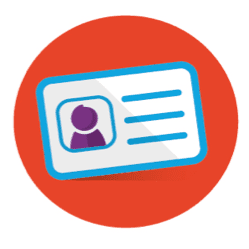8 things we learned from the “digital nations” track of DW24
April 15, 2019 Updated: March 25, 2025
 This was an opportunity to step outside our normal comfort zones and hear from a wide range of non-corporates and expert thinkers on topics as far reaching as how Oxfam supports its frontline workers through technology to the work of the World Bank, from how Save the Children is part of a “Silicon Savannah” in Nairobi to the thoughts of US Presidential Candidate Andrew Yang on automation. And this is the beauty of a 24-hour event; much like a TV series in contrast to a film, it gives you space to explore themes for which you may not normally have time. There was so much that was exciting and inspiring across the Digital Nations Group track, but here are eight lessons that stood out from across our speakers.
This was an opportunity to step outside our normal comfort zones and hear from a wide range of non-corporates and expert thinkers on topics as far reaching as how Oxfam supports its frontline workers through technology to the work of the World Bank, from how Save the Children is part of a “Silicon Savannah” in Nairobi to the thoughts of US Presidential Candidate Andrew Yang on automation. And this is the beauty of a 24-hour event; much like a TV series in contrast to a film, it gives you space to explore themes for which you may not normally have time. There was so much that was exciting and inspiring across the Digital Nations Group track, but here are eight lessons that stood out from across our speakers. 1. Supporting the frontline cannot be optional
Listening to Dianna Langley from Oxfam talk about the impact its enterprise social network (ESN), Workplace by Facebook, has had, really drove home that thinking about your users outside of HQ cannot be optional. With its “Run towards crisis” mentality, Oxfam’s affiliate structure is highly mobile, covering use cases from direct food provision to street fundraising to emergency response. People often have to jump on a plane to respond to humanitarian crises within 24 hours, plan in hand and ready to hit the ground running. Any digital workplace that fails to take these people into consideration would be window dressing only. The Oxfam toolset takes in the ESN, as well as services such as a Drupal-based intranet, ServiceNow, Office 365, single sign-on and file sharing, supporting everything from informal and speedy collaboration to slower, more evergreen, information. The result is that critical knowledge can be more easily and quickly requested, accessed and shared, allowing frontfield staff to learn from the expertise of those across the globe, and HQ to discover success stories that can be repurposed and reused by multiple teams. While companies such as Heathrow Airport, Barclays and COWI all jump to mind as delivering useful services for mobile staff, the ability to step into the shoes of that frontline, with empathy and understanding, is all too often an afterthought for organizations. What we learn from those such as Oxfam, where the frontline is integral to being able to deliver on its mission is that supporting those frontline staff cannot be viewed as optional.
While companies such as Heathrow Airport, Barclays and COWI all jump to mind as delivering useful services for mobile staff, the ability to step into the shoes of that frontline, with empathy and understanding, is all too often an afterthought for organizations. What we learn from those such as Oxfam, where the frontline is integral to being able to deliver on its mission is that supporting those frontline staff cannot be viewed as optional.2. The impact of automation and AI goes beyond the digital workplace
It’s not hard to find reports of how automation is going to severely impact millions of jobs globally, and much that is being written tends to veer between dystopia and utopia, with the truth likely somewhere in between. However, reports from the real world, such as that brought to us by Andrew Yang, are hard to ignore, as he reported his experiences in areas such as Iowa, where he’s seen firsthand the negative impact of automation as people lose their jobs. While we light up with excitement at stories of how organizations such as Liberty Mutual and Avanade are harnessing AI to build intelligent digital workplace assistants, studio guests such as Andrew and Josh Simons reminded us of the human and ethical impact of some of these technologies if they’re not implemented thoughtfully. In areas where jobs are being replaced by automation, organizations and states need to be thinking hard about investing in reskilling those who are likely to find themselves unemployed. For organizations thinking of using AI to support decision-making in areas such as recruitment, they need to be transparent about the algorithms that are driving those decisions.3. Inequality extends to “digital” – but can also be addressed through digital
Digital isn’t a silver bullet that solves all problems. We’ve seen through our benchmarking, for example, that accessibility remains low down the list of priorities for organizations, while an increasingly digital public and private sphere leaves behind those without the connectivity, literacy or ability to join in. It can create a hierarchy of haves and have nots, something we often also see manifested in the HQ/local digital workplace imbalance within organizations. At the same time, going digital creates new opportunities to address questions of inequality. Workforces can extend to talent that may be unable to commute to an office. Voice assistants such as Alexa are helping to deliver council services, covering tasks such as reminders to take medicine. For DW24 live tour guest Te Wānanga o Aotearoa, we saw how a new digital workplace programme, built on Office 365, has helped New Zealand’s second largest tertiary educational institution go where its students are. With over 250,000 Maori students (and another 250,000 “honorary” Maori students) impacted by its “second chance” learning since 1983, the institution often finds itself working in remote areas of the country. Its new digital workplace has delivered successes such as allowing teachers to login from home, saving them from having to travel onsite to work and thus providing them with a better work–life balance.
For DW24 live tour guest Te Wānanga o Aotearoa, we saw how a new digital workplace programme, built on Office 365, has helped New Zealand’s second largest tertiary educational institution go where its students are. With over 250,000 Maori students (and another 250,000 “honorary” Maori students) impacted by its “second chance” learning since 1983, the institution often finds itself working in remote areas of the country. Its new digital workplace has delivered successes such as allowing teachers to login from home, saving them from having to travel onsite to work and thus providing them with a better work–life balance. 4. Physical space planning is a great metaphor for the digital workplace
Hour 6 of DW24 saw a great session with University of Leicester and Lauren Vargas, where we not only heard about the University’s wide-reaching digital campus strategy, but also saw that strategy rendered beautifully in 3D as a physical campus plan. The demonstration followed an interview with Lauren, which included a discussion of how digital workplaces need to be “walkable cities”, and DWG’s Director of Research Elizabeth Marsh picked up on how both were grounding digital ideas in physical analogies. This session brought to mind how we can borrow from concepts such as urban planning to think differently about the digital workplaces we are building and bring a new but familiar language to the digital experience.5. Move over Silicon Valley, say hello to Silicon Savannah
The impact of Silicon Valley feels ubiquitous; the innovations and inventions that have come out of this geographic area touch our lives everyday, and have seen countries and communities try to recreate the effect, such as at Silicon Roundabout in London, UK. However, it’s easy to get caught up in our bubbles and forget that, as Samia Melhem of World Bank reminded us, half the population of the Earth remains unconnected, creating a great digital divide. And while digital technologies are spreading rapidly across developing countries, it takes investment and new public/private partnerships to build the infrastructure and help create the opportunities that can have a positive influence on people’s lives. This is why it was so inspiring to hear not only that World Bank has been working to help fund submarine lines that are bringing internet connectivity to landlocked countries in Africa, but also about the impact that this work is now having. And so, Save the Children’s Lucas Mburu introduced us to the Silicon Savannah that is Nairobi, Kenya. Inspired by the huge investments that corporate organizations are making in the area, Save the Children has set up a TechHub in Nairobi, initially as a pilot and now as an expanded and highly successful outfit that supports Save the Children globally. Fuelled by the high levels of local creative talent, the TechHub is not only offering standard software support, but now providing global services, such as business intelligence, information security and cloud infrastructure support across the NGO. By shifting the focus away from HQs often located in North America or Europe, Lucas showed us that innovation centres are growing in areas with previously underused talent, benefitting not just the organization but also empowering the local communities in which they’re based.6. The digital workplace (and work) doesn’t exist in a bubble
It’s all too easy to get caught up in our day-to-day work as digital workplace practitioners, neglecting the headspace to think about some of the big socioeconomic trends whirling around us and how these too influence the world of work. So it was inspiring and eye-opening to hear from speakers such as Gordon Feller of Meeting of the Minds on his work on smart cities, as well as from those such as Samia of World Bank and Andrew Yang. Gordon, in particular, talked us through the macro trends and forces that are at play and impact the workplace, and enable (or prevent) effective digital working. If organizations are starting to think about the internal employee experience, then others, such as Meeting of the Minds, are thinking even bigger about the urban experience in which many workers are operating. Areas such as infrastructure, the Internet of Things and questions of sustainability are all enabling a new city experience to be imagined, in which some of the Future of Work visions we’re creating can be successfully delivered. Meanwhile, as already mentioned, Andrew Yang talked us through the threat of automation to labour forces, meaning many organizations should now be thinking about reskilling their workers to help them prepare for the future, while also considering the skills that generations to come will need.
7. Corporates can gain inspiration from non-corporates
We’re very used to seeing the big corporates who are leading the way in the digital workplace have their names up in lights, and we often reference them as a way of seeking to help those organizations that are earlier in their journeys. However, DW24 reminded us that inspiration can also be gained from listening to those outside of the private sector, who are often having to deliver powerful and impactful digital workplaces on limited resources. Organizations such as Oxfam, UNHCR and Te Wānanga o Aotearoa are all building exciting solutions for their intended audiences, often drawing on such innovative approaches as University of Leicester’s 3D conception of its digital campus strategy, or the stripped-down and simple information architecture Scottish Government showed us. They’re often investing time and money in digital literacy and behavioural change, and Working out Loud, publically, as they share their findings. We also heard from, for example, Oxfam, Save the Children, World Bank and Gordon Feller, the impact that cross-sector partnerships are having, as well as how NGOs and charities are collaborating to help solve society’s “wicked problems”. With private companies increasingly looking to work with, for example, start-ups, to boost their innovation, the flow of knowledge from the public and third sectors into the private sector is one from which all can benefit.8. Science fiction and futurism are key to anticipating what comes next
“Should we all be science fiction writers?” was a question Paul Miller raised for Studio Guest Lauren Vargas, who is a writer and storyteller, as well as digital workplace strategist, educator and now digital literacy academic for the cultural sector. Lauren responded: “I would say yes. I really do think that all of us don’t necessarily need to be science fiction writers, but should be futurists. Not only do we need to be asking ‘why’, but we need to be asking ‘what if’.” And so it was exciting to hear from speakers such as Lauren, David Brin (also a science fiction writer), and George Muir and Brian Solis (both futurists), as they spoke about the process and craft of thinking not just 5 years ahead but instead towards much more distant horizons. Futurists are tracking and analysing disruptive technologies, and looking to draw patterns to help try and anticipate the future by interrogating the past. Hearing from them, encouraged us to think big and creatively about where the world of work may be going, as well as the implications of certain trends, such as increasing retirement ages, to help inform our thinking in the here and now.Seeking inspiration in unfamiliar places
What the above all seems to add up to is that we can find inspiration in quite unfamiliar places, such as hearing Roberta Lee speak about sustainable fashion. To spark new ideas and perspectives, we often need to look outside our echo chambers. Hearing from those who may have different experiences can help us to transpose those ideas into different contexts, shedding new light on our own challenges. And so, as we start to think about DW24 2020, it was so exciting to see the Digital Nations track of DW24 2019 come to life, and we’re looking forward to continuing to bring you a programme of inspiring stories from across the digital nations sphere.TAKE THE NEXT STEP
Join our next open event

Categorised in: DWG24

